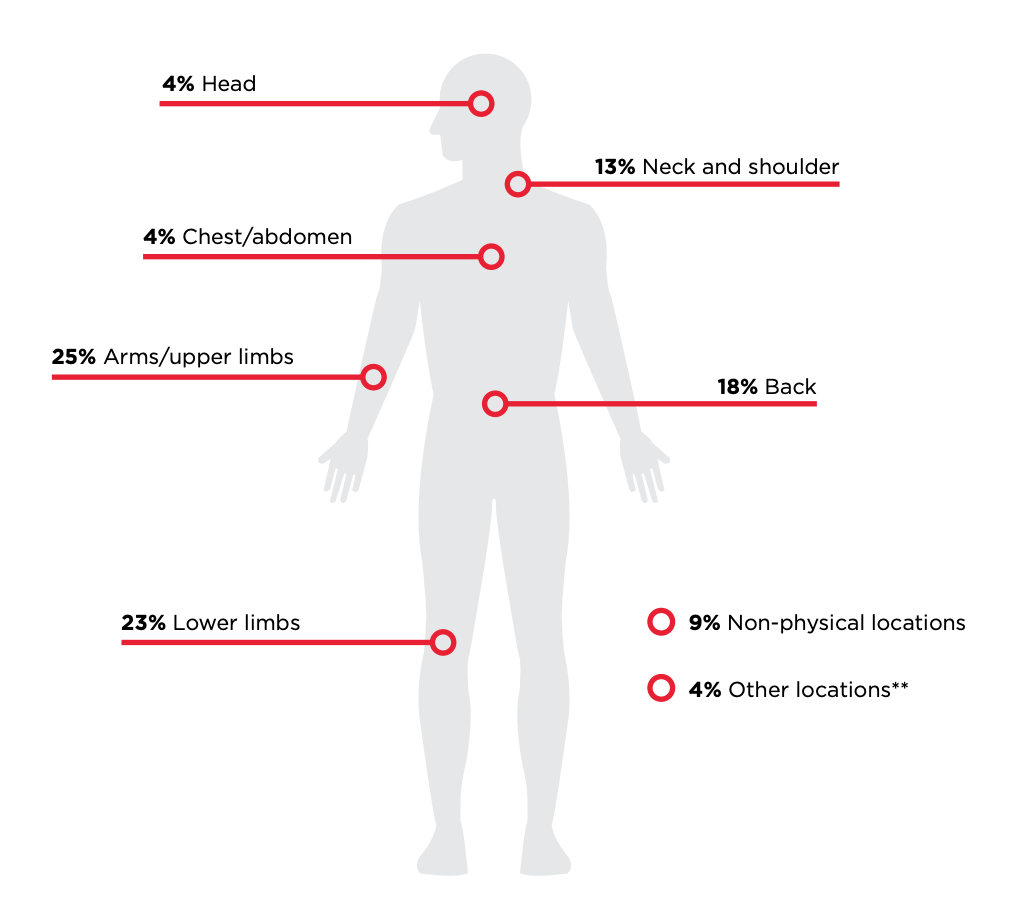Lifting in the workplace should come with a warning sticker!
“Body stressing” or “muscular stress” accounts for 37% of workplace injuries in Australia and 45% of workplace injuries in New Zealand. In both cases, these categories account for the highest percentage of work-related injury claims. Higher than falling, vehicle incidents and walking into things, combined.
In Australia, 44,420 claims were made in these categories and in New Zealand, 13,803 – just last year. That’s a lot of time (and money!) spent on what we would consider to be preventable incidents occuring due to poor workplace lifting technique.
We would love to say it’s improving, but unfortunately, these numbers are still on the rise!
What’s Behind the Crazy Statistics?
Generally, injuries occur when individuals…
- Use incorrect lifting technique,
- Do not have the physical capability to handle the load they are lifting (or attempting to lift)
- Are performing repetitive movements without addressing the tension that builds up.
Worksafe New Zealand really breaks down these statistics, with “muscular stress while lifting, carrying and putting down objects” as the number one cause of injury. Muscular stress through other loaded movements was also notable (such as rotation) and even movements without load – like maneuvering into tricky positions, especially under fatigue.
In regard to what the injuries are, upper limb injuries are the most common in Australia (we do see A LOT of rotator cuff injuries) followed by lower limb and then back injuries.

Image sourced from Safe work Australia (2021)
So How Can You, or Your Staff, Avoid Adding to the Statistics?
You may have heard some of the key phrases when it comes to lifting safely – like “lift with your hips / knees, not your back!”, or “don’t lift and twist!”. In fact these phrases are often the only tutorial we get when entering labor heavy roles….
Although not ideal as an all-encompassing approach, they can be helpful. In the exercise physiology world, we call these phrases “cues” when we are coaching technique. They are simple go-to’s to drive home some of the key components of safe lifting.
Our Top Cues for Safe Workplace Lifting Technique
1. Brace your core
Activating your core muscles will keep your back safe – by creating a muscular ‘brace’ around the spine. This allows your body to transfer load through the torso effectively, sharing it between the muscles instead of loading up the back muscles.
2. Keep your spine “neutral” (straight)
Commonly, injuries happen when we round the lower back (i.e. bending forward – think deadlifting), arch the back (i.e. sticking your butt out – think overhead pressing) or have the head somewhere it shouldn’t be – all positions outside of what we call “neutral”. These positions stack the spine in ways that, biomechanically, are not as resilient against stresses and strains.
3. Keep the load close to your body
This one is all about reducing the length of levers! By keeping loads close to our center of gravity, we reduce the effort required to counteract the weight. This puts less stress on our muscles and joints.
4. Bend your knees
Most of us have heard this one before! Especially applicable for floor to waist lifting – bending your knees means that your back doesn’t have to do all the heavy lifting (pun intended). Don’t just bend over!
5. Adopt a suitable/stable base of support
“Feet outside of shoulder-width” is the most common stance we suggest for lifting tasks. A wider base of support makes us more stable and less likely to compensate in unhelpful ways.
It is important to note that even with all of these things in your favor, you can’t lift everything. It is the job of the employer to provide lifting aids if it is outside of the capabilities of the employee. Not to mention that even the best of athletes lose form when they’re past the point of fatigue.
What we’re saying is, on top of keeping these “cues” in mind, know your limit, and lift within it!
A Note For Employers
What education have you provided your staff for safe lifting in the workplace?
Why not forward them this blog, or better yet, connect with the team at Reva Wellness? Our sister company specialises in manual handling training – done differently!
References:
- https://www.safeworkaustralia.gov.au/sites/default/files/2021-10/Key%20work%20health%20and%20safety%20statistics%20Australia%202021.pdf
- https://data.worksafe.govt.nz/graph/summary/injuries_week_away
Author: Tessa Nielsen
Editor: Yolanda van Vugt
Clinical Exercise Physiologists and Content Creators at Specialised Health
Let’s connect, find us:
Have you got a claimant that would benefit from E.P. support? Refer to the team!
#exercisephysiology #exerciserehab #rehabilitation #lifeinsurance #incomeprotection #ctp #workcover #mobile #telehealth #telehealthprogram #mobileexercisephysiology #returntowork #fatigue #mentalhealth #cancer #musculoskeletal #pain #physio #physiotherapy #Sydney #Brisbane #Melbourne #Adelaide #Auckland #Waikato #BayofPlenty #Wellington #Otago #Christchurch
